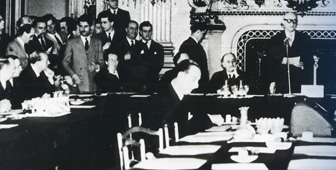
The ‘Historical events in the European integration process’ collection presents and analyses the milestones that shaped the European integration process from 1945 to 2009.
 Historical events
Historical events Introduction© CVCE
Introduction© CVCE  1945-1949.
1945-1949.
The pioneering phase Plans and initiatives to rebuild Europe after the Second World War.© EU  1950-1954.
1950-1954.
The formation of the community of Europe Robert Schuman’s declaration on 9 May 1950: the context and background, the declaration itself and its application via the creation of the ECSC.© European Parliament  1955-1957.
1955-1957.
The European revival and the Rome Treaties The context and implications of the negotiations that led to the signing of the EEC and Euratom Treaties in Rome on 25 March 1957.© European Parliament  1958-1968.
1958-1968.
Successes and crises The establishment of the Common Market and the CAP in the early days of the EEC: successful ventures during a period of crisis.© EU  1969-1979.
1969-1979.
Completion, deepening and widening The Hague Summit of December 1969 and its impact: efforts for revival hampered by economic and international crises.© European Parliament  1980-1986.
1980-1986.
Enlargement to the south and the Single European Act The European dynamic in the 1980s: from the southern enlargement of the European Communities to the adoption of the Single European Act and the Schengen Agreement.© Fritz Behrendt  1987-1997.
1987-1997.
The European Union in a Europe in the throes of change The reinvention of the European Communities in a changing geopolitical environment: monetary integration, the plans for eastward enlargement and treaty reforms. Signing of the Maastricht Treaty (7 February 1992).© EU  1998-2009.
1998-2009.
The unification of Europe The unification of Europe at the turn of the 21st century: the single currency, the accession of the countries of Central and Eastern Europe and the adoption of the Treaty of Lisbon.© EU
